Foreign Insulators
by Marilyn Albers
Reprinted from "Crown Jewels of the Wire", December 1987, page 20
ELEKTRIKA!
Do you remember this porcelain enamel sign that was pictured on the front
cover of the May, 1987 CROWN JEWELS OF THE WIRE? It belongs to Hans Kettenburg
(Anchorage, AK) and was included in his article, "High Voltage & Power
Company Signs," beginning on page 13 of that issue. He wrote: "Not
sure what language Elektrika is -- anybody?"
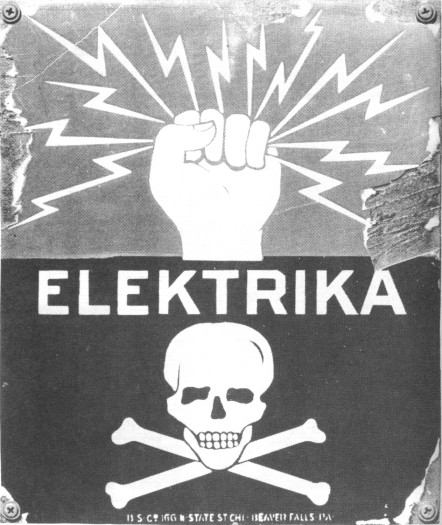
Large Image (193 Kb)
Well, as luck would have it, I found an almost identical sign at the Fresno
National on Chuck Irwin's table. Clarice Gordon found it first and hailed me.
Bless her!
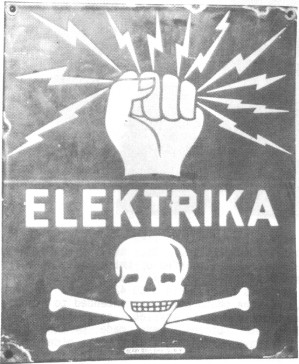
Large Image (96 Kb)
Both signs are 10" x 12", but there are slight differences as you
can see from the two pictures. The sign belonging to Hans (left) has 12
lightning bolts, while mine (right) has only 11. Also, there are variations in
size of bones, fullness of skull, shape of teeth and placement of fist.
Different artists' interpretations! My sign is red, white and blue and was put
out by the Ready Made Sign Co., NY. The other, sporting colors of red, white and
black, came from the B.S. Co. with factories located at 166 N. State Street,
Chicago and Beaver Falls, Pennsylvania.
A bit of research showed that the word ELEKTRIKA means "electric
machine" or "electricity" and comes from the Slovak language.
Slovak is one of the two official languages of Czechoslovakia, the other being
Czech, which is the more highly developed of the two. I would guess that these
signs were used here in the States in an area heavily populated with people of
Czechoslovakian descent and where Slovak was the principal language. Such an
area exists in and around La Grange, Texas -- about 85 miles from Houston. Anyway,
these signs are neat, neat, NEAT! And isn't a picture like this worth a thousand
words? Would you proceed any further if you saw this wallop of electricity
promising certain death?
FRUIT JARS AND THINGS
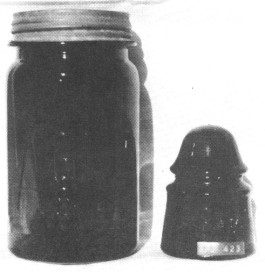
As you may have gathered, I do like to pick up a few "go-withs" for
my foreign insulator collection. So, as I was going by Bernie Warren's table at
the National, I scarfed up this beautiful one quart size amber fruit jar marked
AGEE Special. The word AGEE also appears on the zinc lid. The jar goes nicely
with a CD 423 A.G.M. insulator of the exact same color, as the photo below was
intended to show. But you are looking at a black and white version, so you'll
just have to use your imagination! Both pieces were made by the Australian Glass
Manufacturing Company. The fruit jar, being older, was produced before 1948 at
the company's Sydney location. The insulator came from the plant in Hobart,
Tasmania, and was made after 1950. Bernie brought several fruit jars and many
beautiful insulators back from a recent trip he made to Australia.
So, what else did I find on his table? All three insulators you see in the
photo below are purple and are marked AGEE. Once again, they were made by the
Australian Glass Manufacturing Company in Sydney sometime between 1931 and 1948.
Is the insulator in the center a CD 421 or a CD 422? The crown is more round and
full than either of its Aussie cousins and so it doesn't fit either
classification. Bernie knows of only about 2 or 3 like this one and it seems
like it was not just a case of a collapsed crown on a CD 422, but that it was an
intended mold variation. We may never know for sure but "Woody" has
made his pronouncement about the piece and has given it a new CD number -- CD
421.1. It is a welcome addition to my collection of Australian insulators.
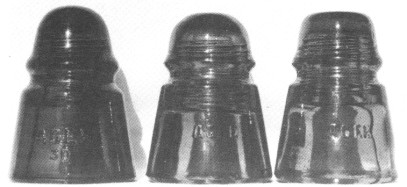
A BABY POTHEAD
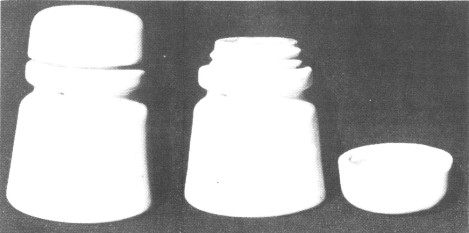
Robert Chiantelli (Monterey, CA) had this little white porcelain fella in his
hand when he came to the National in Fresno. He has relatives in Italy and he
brought the insulator back from a trip over there not too long ago.
While we often refer to this particular style as a "pothead," it is
actually a dry spot insulator. It has two holes for the lead in wires, similar
to U-1935 (see page 40, WORLDWIDE PORCELAIN INSULATORS, Albers/Tod, 1982). The
purpose of this design is to provide a "dry spot" on the lead in wire
and thus prevent wet weather shorting.
This little pothead is quite a bit shorter than most examples of this style
that I have seen. It stands only 3-7/8" tall and we most likely will assign
it a separate U-number.
The marking, which is under glaze green ink, spells out the word GINORI. It
appears both on the crown and on the shoulder of the insulator. Richard Ginori
is a modern factory in Milan, Italy, that not only manufactures a complete line
of electrical insulators, but porcelain dinnerware as well. It was exciting to
find this insulator!
A PRIZE LEFT BEHIND IN GUERNSEY
Let me share with you a part of a recent letter from my good friend, Keith
Neal of Guernsey, Channel Islands:
"Just seen in CROWN JEWELS (May, 1987) your pictures of the VEGLA style
insulators, page 31. I enclose one taken off a house here in Guernsey which had
been out of use for a long time. My excellent friend, Mr. Le Page, head of
Telecom, had his "gang" remove it and there is no doubt it is German --
put up during the occupation of these Islands in the '39 to '45 War. Several
were spotted by my lady valet and I looked at them, then found several more. All
on "State houses." I expect the German Occupation Museum will be
wanting an example. When Mr. Le Page got some down for me he said, "they
are not ours -- probably German Occupation." He was right. I can, in fact,
remember vaguely seeing them in Guernsey years ago. The ones in Guernsey are CD
597. I have also spotted what I believe are CD 448's. The ones Mr. Le Page got
down were all on swan-neck brackets -- the insulator strongly cemented onto the
bracket and the bracket strongly cemented into the brickwork. So his gang has a
hard time chipping away the brick to get them out and then making good the
damage. There is now no doubt they are German and used on certain private lines
put up during the Occupation in addition to the regular Telecom System they took
over."
Thanks, Keith, for sharing this story. Your CD 597 N 80 VEGLA is shown below
in the photo. The 1/4 size drawings of both CD 597 and CD 448 VEGLA were done by
Jack Tod. You may remember that we recently found out what the word VEGLA stands
for, as reported in that same May, 1987, issue of German glass manufacturer with
factories in Rheinland, Aachen and Cologne.
Incidentally, Keith tells me that, if his health permits, he is going to try
to make the trip to Houston for the NIA National Convention in July, 1988. By
way of gentle persuasion, shall we tell him that we have our fingers crossed and
that it would be a real highlight of the show if he were here? Consider it done
-- he's reading this just as you are!
Look for Don Fiene's 1987 Soviet Insulator Report coming out in the February
issue of CROWN JEWELS!
| 